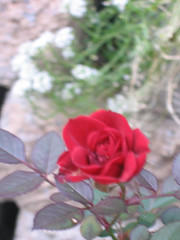Tuesday, November 28, 2006
Wednesday, November 22, 2006
29 Days Left
Yesterday, after I wrote a post about how I wouldn’t be posting much (how ironic is that?), I realized that we had one month left until the winter solstice. Hooray!
Why am I excited? It isn’t just because I’m a pagan. It isn’t just because the solstice marks the point at which the days actually start to get LONGER again. It is because the solstice is the traditional day to begin Winter Sowing! Yes, I still have plants from last year’s winter sowing extravaganza to put in the ground, but I couldn’t help buying more seeds. I found a bunch of fun shade and wildflower seeds on the Garden Makers website. They’ve been chilling in my fridge since September.
I thought I’d give everyone a (little less than) one month warning so that you could be sure to procure your seeds before December 21. If you haven’t tried Winter Sowing before, visit the “how to” page and the Winter Sowing forum on GardenWeb. I’ll be keeping you up to date with lists of seeds sown and exciting pictures of milk jugs filled with dirt.
Why am I excited? It isn’t just because I’m a pagan. It isn’t just because the solstice marks the point at which the days actually start to get LONGER again. It is because the solstice is the traditional day to begin Winter Sowing! Yes, I still have plants from last year’s winter sowing extravaganza to put in the ground, but I couldn’t help buying more seeds. I found a bunch of fun shade and wildflower seeds on the Garden Makers website. They’ve been chilling in my fridge since September.
I thought I’d give everyone a (little less than) one month warning so that you could be sure to procure your seeds before December 21. If you haven’t tried Winter Sowing before, visit the “how to” page and the Winter Sowing forum on GardenWeb. I’ll be keeping you up to date with lists of seeds sown and exciting pictures of milk jugs filled with dirt.
Tuesday, November 21, 2006
Sidetracked, For Now
Mike and I took a trip to Gatlinburg in mid-October. It was great to spend time together without all the demands of school, work, home, hobbies, and pets (four cats can be a handful). We spent hours talking. Over breakfast one morning, while in one of my more philosophical moods, I declared that Mike’s personality could be summed up in one word: “winner.” As evidence, I pointed out how he likes to “win” at everything: school, arguments, poker, ultimate Frisbee, driving, naming the artist of songs playing on the radio. I asked him what my word would be and he said that he didn’t know. (Mike doesn’t like to play the psychoanalyze game.) Undaunted by his lack of participation in my philosophical ruminations, I decreed myself “creator.”
I’m not referring to my goddess complex. Rather, I realized that a common thread runs among the things I like to do; they all involve making something. Cooking (when I actually do that), sewing, decorating, acting, woodworking, dancing, writing, and gardening are all creative activities. I think most gardeners are creative types. With winter approaching, the gardening blogs I read are full of knitting, quilting, tablescapes, decorating, and cooking. Cozy, homey activities.
I’d be at home, making something too (like the windowboxes that I bought all this darn wood for last spring) and posting all about it on this blog, but I’ve been sidetracked by one of my out-of-the-home creative activities – acting. Generally, I don’t post details about my shows because it would mostly be full of complaints about actors who don’t learn their lines (argh!) or directors that keep me up past my bedtime. I need to keep those thoughts private if I want anyone to ever cast me again. Even if I did use the web to publicly rant, it wouldn’t be on this blog, but on Wawa’s World.
The point of all this, and I do have a point, is that my blogging here will be sporadic until spring. I plan on getting some projects done during the holidays, but most of my free time is taken up with learning lines, rehearsing, performing, and recovering from wild cast parties. (Oh yeah, and I have to work full-time too, pbbbbbt!) My creative juices are still flowing, just not in a home and garden sort of way. I’m still here and reading all of your blogs, though.
I’m not referring to my goddess complex. Rather, I realized that a common thread runs among the things I like to do; they all involve making something. Cooking (when I actually do that), sewing, decorating, acting, woodworking, dancing, writing, and gardening are all creative activities. I think most gardeners are creative types. With winter approaching, the gardening blogs I read are full of knitting, quilting, tablescapes, decorating, and cooking. Cozy, homey activities.
I’d be at home, making something too (like the windowboxes that I bought all this darn wood for last spring) and posting all about it on this blog, but I’ve been sidetracked by one of my out-of-the-home creative activities – acting. Generally, I don’t post details about my shows because it would mostly be full of complaints about actors who don’t learn their lines (argh!) or directors that keep me up past my bedtime. I need to keep those thoughts private if I want anyone to ever cast me again. Even if I did use the web to publicly rant, it wouldn’t be on this blog, but on Wawa’s World.
The point of all this, and I do have a point, is that my blogging here will be sporadic until spring. I plan on getting some projects done during the holidays, but most of my free time is taken up with learning lines, rehearsing, performing, and recovering from wild cast parties. (Oh yeah, and I have to work full-time too, pbbbbbt!) My creative juices are still flowing, just not in a home and garden sort of way. I’m still here and reading all of your blogs, though.
Monday, November 13, 2006
Done with Bulbs
There are NO bulbs in my refrigerator! At one point this fall, fully half the space in the fridge was occupied by bulbs, corms, rhizomes, and roots. I planted the last of them yesterday morning.
I am so tired of hoeing. After chopping at the dirt for eight months, I’ve finally worn my back out. I’ve had to lighten up on the trunk exercises I teach in my Thursday and Friday abs class so that I am still fresh enough to garden all weekend. Repetitive hoeing is not good for one’s back.
My refrigerator is empty, but I’m not entirely sure I can keep it that way. I’ve been frequenting the bulb forum on Gardenweb, drooling over spring pictures. I must keep reminding myself that every lovely tulip and daffodil comes at the expense of my aching back. Besides, I need to save some “fun” for next fall!
I am so tired of hoeing. After chopping at the dirt for eight months, I’ve finally worn my back out. I’ve had to lighten up on the trunk exercises I teach in my Thursday and Friday abs class so that I am still fresh enough to garden all weekend. Repetitive hoeing is not good for one’s back.
My refrigerator is empty, but I’m not entirely sure I can keep it that way. I’ve been frequenting the bulb forum on Gardenweb, drooling over spring pictures. I must keep reminding myself that every lovely tulip and daffodil comes at the expense of my aching back. Besides, I need to save some “fun” for next fall!
Wednesday, November 08, 2006
Negative Space
I’ve always been fascinated with negative space. I mean that in the artistic sense, not the scientific, anti-matter and dark energy sense. I’m one of those people that will stare at the patterns in a hotel ballroom floor to study the shapes created in the space outside the fleur-de-lis. I look for the faces in Rubin’s vase. When I was in highschool I was obsessed with drawing giraffe spots on my papers. However, I didn’t draw the spots, but rather the winding paths around the spots. What I learned from this exercise was that concentrating on the negative space when creating a pattern can give you more fluid, natural results than focusing on the positive space.
I try to give the negative space that same, careful attention when I create new beds in our yard. The beds are the positive space, and the paths and lawn are the negative. By concentrating on creating interesting negative shapes, the resulting garden beds seem to relate to the overall landscape, instead of looking plopped into the lawn.
On the landscape design forum, on GardenWeb, the use of island beds (especially in the home garden) is hotly debated. Most people, rightly so, believe that island beds look artificial and stiff. They are usually composed of a small berm, planted with evergreens, floating in the middle of a sea of grass. I’ve seen quite a bit of discussion on the proper height, width, and length of an island bed in order for it to look integrated into the yard. I believe the guidelines can be pretty much disregarded if one merely concentrates on the negative space of the lawn. If the island bed’s creation results in a pleasing flow of grass or groundcover around it, it will not look unnatural.
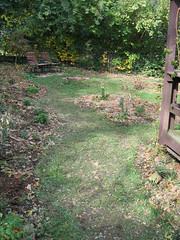 Enough with theory, though. I’d like to share some examples from my own yard. First, the pond area. When I added scallops to the candycane bed and a swoop to the bed in front of the deck, I realized that I had the opportunity to create exciting, winding grass paths in the negative space I had created. I added an island bed in the corner of lawn between the deck and candycane bed. Its contours mirror those of the two aforementioned beds and the round pond. I envisioned the beds and pond like the continents of Pangaea that had drifted away from each other over the grassy sea. Of course, my anal-retentive sense of balance forced me to add another island bed, on the other side of the pond area to balance the first. I adore the resulting, wandering paths and the symmetrical, if not quite circular, patch of grass carved out around the pond. The result is still a little raw (most of what you see here was created this past season), but I can imagine what it will look like when the dozens of bulbs I have planted here spring to life.
Enough with theory, though. I’d like to share some examples from my own yard. First, the pond area. When I added scallops to the candycane bed and a swoop to the bed in front of the deck, I realized that I had the opportunity to create exciting, winding grass paths in the negative space I had created. I added an island bed in the corner of lawn between the deck and candycane bed. Its contours mirror those of the two aforementioned beds and the round pond. I envisioned the beds and pond like the continents of Pangaea that had drifted away from each other over the grassy sea. Of course, my anal-retentive sense of balance forced me to add another island bed, on the other side of the pond area to balance the first. I adore the resulting, wandering paths and the symmetrical, if not quite circular, patch of grass carved out around the pond. The result is still a little raw (most of what you see here was created this past season), but I can imagine what it will look like when the dozens of bulbs I have planted here spring to life. 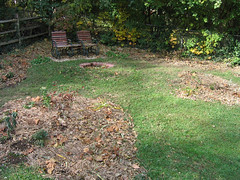
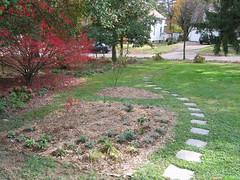 In the front yard, I laid the winding, stepping stone path with the intent of eventually creating beds along both sides of it. With our heavy clay soil, I can only provide the woman-power to create a limited number of beds each season. This year, I started with the first two beds on the shady side of the walk, near the house, inside a curve. I was initially going to make only one bed, but it seemed too large, so I cut it in two with a grass walkway. I’m not entirely pleased with the shapes. Looking at the positive space, the larger bed is disturbingly close to rectangular. The smaller bed, while objectively a good shape, creates a grass path of an odd width between it and the shady shrub border to the left. I plan on adjusting the edges of the shrub border to correct the problem. I’m stumped on the rectangular bed. I like the negative space around it, though, and I’m hoping that the bed’s geometric shape will be camouflaged when the plants fill in.
In the front yard, I laid the winding, stepping stone path with the intent of eventually creating beds along both sides of it. With our heavy clay soil, I can only provide the woman-power to create a limited number of beds each season. This year, I started with the first two beds on the shady side of the walk, near the house, inside a curve. I was initially going to make only one bed, but it seemed too large, so I cut it in two with a grass walkway. I’m not entirely pleased with the shapes. Looking at the positive space, the larger bed is disturbingly close to rectangular. The smaller bed, while objectively a good shape, creates a grass path of an odd width between it and the shady shrub border to the left. I plan on adjusting the edges of the shrub border to correct the problem. I’m stumped on the rectangular bed. I like the negative space around it, though, and I’m hoping that the bed’s geometric shape will be camouflaged when the plants fill in.
My garden design isn’t perfect, but I believe my negative technique is a valid one. As I pile leaves in areas of the lawn destined to be new shade beds next year, I pay careful attention to both the face (lawn) and the vase (bed). I’m currently scheming to figure out how I can create something similar to Susan’s oval lawn (which is a GREAT example of bringing the negative space to the focus). If you drive by and observe me raking leaves into odd patterns and squinting my eyes, you’ll know that I’m trying to achieve the perfect balance between the positive and negative.
I try to give the negative space that same, careful attention when I create new beds in our yard. The beds are the positive space, and the paths and lawn are the negative. By concentrating on creating interesting negative shapes, the resulting garden beds seem to relate to the overall landscape, instead of looking plopped into the lawn.
On the landscape design forum, on GardenWeb, the use of island beds (especially in the home garden) is hotly debated. Most people, rightly so, believe that island beds look artificial and stiff. They are usually composed of a small berm, planted with evergreens, floating in the middle of a sea of grass. I’ve seen quite a bit of discussion on the proper height, width, and length of an island bed in order for it to look integrated into the yard. I believe the guidelines can be pretty much disregarded if one merely concentrates on the negative space of the lawn. If the island bed’s creation results in a pleasing flow of grass or groundcover around it, it will not look unnatural.
 Enough with theory, though. I’d like to share some examples from my own yard. First, the pond area. When I added scallops to the candycane bed and a swoop to the bed in front of the deck, I realized that I had the opportunity to create exciting, winding grass paths in the negative space I had created. I added an island bed in the corner of lawn between the deck and candycane bed. Its contours mirror those of the two aforementioned beds and the round pond. I envisioned the beds and pond like the continents of Pangaea that had drifted away from each other over the grassy sea. Of course, my anal-retentive sense of balance forced me to add another island bed, on the other side of the pond area to balance the first. I adore the resulting, wandering paths and the symmetrical, if not quite circular, patch of grass carved out around the pond. The result is still a little raw (most of what you see here was created this past season), but I can imagine what it will look like when the dozens of bulbs I have planted here spring to life.
Enough with theory, though. I’d like to share some examples from my own yard. First, the pond area. When I added scallops to the candycane bed and a swoop to the bed in front of the deck, I realized that I had the opportunity to create exciting, winding grass paths in the negative space I had created. I added an island bed in the corner of lawn between the deck and candycane bed. Its contours mirror those of the two aforementioned beds and the round pond. I envisioned the beds and pond like the continents of Pangaea that had drifted away from each other over the grassy sea. Of course, my anal-retentive sense of balance forced me to add another island bed, on the other side of the pond area to balance the first. I adore the resulting, wandering paths and the symmetrical, if not quite circular, patch of grass carved out around the pond. The result is still a little raw (most of what you see here was created this past season), but I can imagine what it will look like when the dozens of bulbs I have planted here spring to life. 
 In the front yard, I laid the winding, stepping stone path with the intent of eventually creating beds along both sides of it. With our heavy clay soil, I can only provide the woman-power to create a limited number of beds each season. This year, I started with the first two beds on the shady side of the walk, near the house, inside a curve. I was initially going to make only one bed, but it seemed too large, so I cut it in two with a grass walkway. I’m not entirely pleased with the shapes. Looking at the positive space, the larger bed is disturbingly close to rectangular. The smaller bed, while objectively a good shape, creates a grass path of an odd width between it and the shady shrub border to the left. I plan on adjusting the edges of the shrub border to correct the problem. I’m stumped on the rectangular bed. I like the negative space around it, though, and I’m hoping that the bed’s geometric shape will be camouflaged when the plants fill in.
In the front yard, I laid the winding, stepping stone path with the intent of eventually creating beds along both sides of it. With our heavy clay soil, I can only provide the woman-power to create a limited number of beds each season. This year, I started with the first two beds on the shady side of the walk, near the house, inside a curve. I was initially going to make only one bed, but it seemed too large, so I cut it in two with a grass walkway. I’m not entirely pleased with the shapes. Looking at the positive space, the larger bed is disturbingly close to rectangular. The smaller bed, while objectively a good shape, creates a grass path of an odd width between it and the shady shrub border to the left. I plan on adjusting the edges of the shrub border to correct the problem. I’m stumped on the rectangular bed. I like the negative space around it, though, and I’m hoping that the bed’s geometric shape will be camouflaged when the plants fill in.My garden design isn’t perfect, but I believe my negative technique is a valid one. As I pile leaves in areas of the lawn destined to be new shade beds next year, I pay careful attention to both the face (lawn) and the vase (bed). I’m currently scheming to figure out how I can create something similar to Susan’s oval lawn (which is a GREAT example of bringing the negative space to the focus). If you drive by and observe me raking leaves into odd patterns and squinting my eyes, you’ll know that I’m trying to achieve the perfect balance between the positive and negative.
Monday, November 06, 2006
Overwintering the Babies
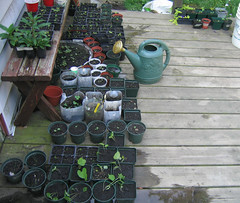 I had great success with winter sowing last year. During the growing season, I planted out as many seedlings as I could, but some were too small to put into the ground. Others were large enough, but their new home will not be ready until next spring. So, my deck and rose bed became nurseries for most of the summer. As the season ended, though, I knew that I needed to find a more sheltered home for them to overwinter.
I had great success with winter sowing last year. During the growing season, I planted out as many seedlings as I could, but some were too small to put into the ground. Others were large enough, but their new home will not be ready until next spring. So, my deck and rose bed became nurseries for most of the summer. As the season ended, though, I knew that I needed to find a more sheltered home for them to overwinter.I initially planned to set the dozens of little pots in disposable roasting pans in the garage. I overwintered potted trees in this manner last year. I was worried, though, that I wouldn’t give them adequate water and that the garage may get too cold for such tiny pots. The ideal solution would be to sink the pots in some unused garden space and mulch with leaves, but I didn’t have any empty space.
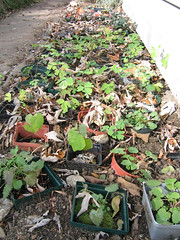 When I decided to rip out all the plantings in the garage bed in order to grow vegetables next year, I not only freed up garden space, I freed up garden space with well worked topsoil. (A previous owner removed the native clay and filled it with a loamy mix.) It was a piece of cake to “plant” my little pots in the earth. Believe it or not, I ran out of room before I finished! My less desirable plants will be overwintering in the pit of despair.
When I decided to rip out all the plantings in the garage bed in order to grow vegetables next year, I not only freed up garden space, I freed up garden space with well worked topsoil. (A previous owner removed the native clay and filled it with a loamy mix.) It was a piece of cake to “plant” my little pots in the earth. Believe it or not, I ran out of room before I finished! My less desirable plants will be overwintering in the pit of despair.With at least one hundred little perennials awaiting a home, you would think that I wouldn’t have dozens of new seeds to sow this winter, but I do. What can I say? I’m a plantaholic. At least I’m in good company.
Thursday, November 02, 2006
Gardening Commandment #2?
I’m a neat and tidy sort of person. My Marines used to move my desktop items around when I stepped out of the office just to giggle at me readjusting them mere centimeters back to their proper places when I returned. I initially applied my orderly attitude to gardening. I’ve already discussed how unappealing planting in straight lines turned out to be. I also took a rather anal approach to plant groupings. I would plant them in a straight line, alternating varieties, creating orderly patterns of two or three. The results were not categorically ridiculous, but the patterns usually looked quite artificial.
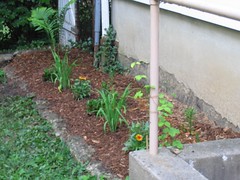 For instance, in my sunset bed, I initially planted six plants along the edge: two each of cardinal lobelia, red daylilies, and goblin gaillardia. Let’s forget for a moment that the cardinal lobelia abhor a dry, northwestern exposure and I had to move them and that the gaillardia fried to death in a few short months. Had all the plants lived, the result would have been much more appropriate to an amusement park planting than a cottage garden. The pattern, rather than the overall effect, becomes the focus. Planting in 3’s is recommended, but that doesn’t mean to plant in patterns of three.
For instance, in my sunset bed, I initially planted six plants along the edge: two each of cardinal lobelia, red daylilies, and goblin gaillardia. Let’s forget for a moment that the cardinal lobelia abhor a dry, northwestern exposure and I had to move them and that the gaillardia fried to death in a few short months. Had all the plants lived, the result would have been much more appropriate to an amusement park planting than a cottage garden. The pattern, rather than the overall effect, becomes the focus. Planting in 3’s is recommended, but that doesn’t mean to plant in patterns of three.
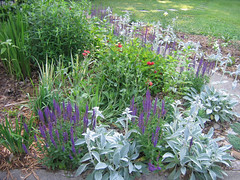 My experiences with patterns of two have been better. Along the front walk, I’ve planted lamb’s ear alternating with East Friesland sage. Although the lamb’s ear needs twice yearly, savage pruning to keep it from consuming the sage, the result is pleasing. The orderliness nicely balances the wild jungle of flowers in the rest of the bed. I’ve also seen nice results with patterns of two in other people’s yards and at Friendship Park.
My experiences with patterns of two have been better. Along the front walk, I’ve planted lamb’s ear alternating with East Friesland sage. Although the lamb’s ear needs twice yearly, savage pruning to keep it from consuming the sage, the result is pleasing. The orderliness nicely balances the wild jungle of flowers in the rest of the bed. I’ve also seen nice results with patterns of two in other people’s yards and at Friendship Park.
Generally, though, I try to avoid patterns of even two, now. The result is formal, even a bit military, and that’s not my style (any more). In fact, I try to steer other people away from it as well. I think it is most tempting to create patterns when you are torn between two or more different plants or varieties. You think, “Well, since I can’t decide, I’ll just get an equal number of each and alternate them!” Don’t do it! If you’re planting in a line (hedge or edging), choose one variety only or choose many and don’t plant them in a discernible pattern (mixed hedges). If you aren’t planting in a line, go ahead and get both plants, but plant them each in their own little blobs (drifts, if you will).
Straight lines and patterns look great in the gardens of Versailles, but they just appear unimaginative and uptight in anything smaller. I guess my Second Gardening Commandment would be to Avoid Planting in Patterns. Unless you’re growing a living chessboard or something. That would be kind of cool.
 For instance, in my sunset bed, I initially planted six plants along the edge: two each of cardinal lobelia, red daylilies, and goblin gaillardia. Let’s forget for a moment that the cardinal lobelia abhor a dry, northwestern exposure and I had to move them and that the gaillardia fried to death in a few short months. Had all the plants lived, the result would have been much more appropriate to an amusement park planting than a cottage garden. The pattern, rather than the overall effect, becomes the focus. Planting in 3’s is recommended, but that doesn’t mean to plant in patterns of three.
For instance, in my sunset bed, I initially planted six plants along the edge: two each of cardinal lobelia, red daylilies, and goblin gaillardia. Let’s forget for a moment that the cardinal lobelia abhor a dry, northwestern exposure and I had to move them and that the gaillardia fried to death in a few short months. Had all the plants lived, the result would have been much more appropriate to an amusement park planting than a cottage garden. The pattern, rather than the overall effect, becomes the focus. Planting in 3’s is recommended, but that doesn’t mean to plant in patterns of three. My experiences with patterns of two have been better. Along the front walk, I’ve planted lamb’s ear alternating with East Friesland sage. Although the lamb’s ear needs twice yearly, savage pruning to keep it from consuming the sage, the result is pleasing. The orderliness nicely balances the wild jungle of flowers in the rest of the bed. I’ve also seen nice results with patterns of two in other people’s yards and at Friendship Park.
My experiences with patterns of two have been better. Along the front walk, I’ve planted lamb’s ear alternating with East Friesland sage. Although the lamb’s ear needs twice yearly, savage pruning to keep it from consuming the sage, the result is pleasing. The orderliness nicely balances the wild jungle of flowers in the rest of the bed. I’ve also seen nice results with patterns of two in other people’s yards and at Friendship Park.Generally, though, I try to avoid patterns of even two, now. The result is formal, even a bit military, and that’s not my style (any more). In fact, I try to steer other people away from it as well. I think it is most tempting to create patterns when you are torn between two or more different plants or varieties. You think, “Well, since I can’t decide, I’ll just get an equal number of each and alternate them!” Don’t do it! If you’re planting in a line (hedge or edging), choose one variety only or choose many and don’t plant them in a discernible pattern (mixed hedges). If you aren’t planting in a line, go ahead and get both plants, but plant them each in their own little blobs (drifts, if you will).
Straight lines and patterns look great in the gardens of Versailles, but they just appear unimaginative and uptight in anything smaller. I guess my Second Gardening Commandment would be to Avoid Planting in Patterns. Unless you’re growing a living chessboard or something. That would be kind of cool.
